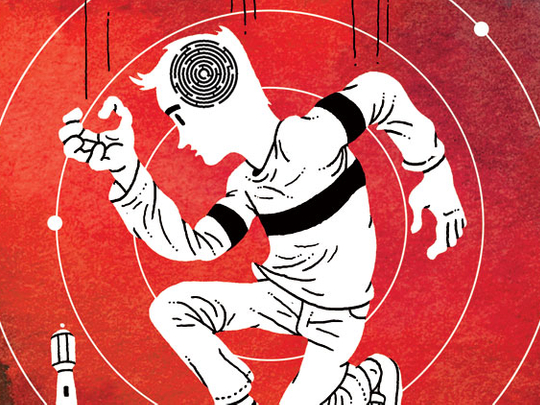
It is easier for a camel to go through the eye of a needle than for a novelist to gain entry to the lit-fic kingdom of heaven, wherein you are both critically acclaimed and wildly popular.
Yet David Mitchell is, as it were, that camel. There was no waiting at the gate; with the publication of his first novel, “Ghostwritten”, he passed straight through to the other side. Later, Mitchell’s celestial residence was confirmed when “Cloud Atlas” triumphed in the Richard and Judy Book Club while being simultaneously hailed by critics as a virtuoso work of hyperrealism.
Readers followed reviewers, or reviewers followed readers, and consensus hardened into orthodoxy. On one website, where books are assessed by star ratings, a nervous detractor recently wrote: “I am going to hell for giving David Mitchell 2 stars.” Why? Popularity, in life and in art, is often about charm. Why do we like certain people? Why do we like certain novelists? Roberto Bolano, Charles Dickens, Mark Twain, J.K. Rowling, to name a few writers-of-popular-repute, are charming literary mesmerists: they sidle up to the reader, draw him/her in.
At the other end of this theoretical spectrum we have Shock (Louis-Ferdinand Celine, Tristan Tzara, Gertrude Stein et cetera) but shock takes longer to evolve into popularity, and may evolve into obscurity and starvation instead.
Mitchell is a brilliant literary mesmerist: “Ghostwritten”, “Cloud Atlas” and now “The Bone Clocks” use multiple first-person narrators; each narrator departs before they outstay their welcome, like the most charming of guests. “Black Swan Green”, “number9dream” and now again “The Bone Clocks” use teenage narrators, deployed as sympathetic idiots savants.
It is no coincidence that the only novel of Mitchell’s which received mixed reviews was the (largely) third-person “The Thousand Autumns of Jacob de Zoet”. This was a less instantaneously charming book, because Mitchell dispensed with the mesmeric first-person.
Mitchell is also, like many of his readers, in love with literature as a parallel reality, and his work is part-tribute to authors he admires, riff and rearrangement, at times akin to high-quality fan fiction. “Cloud Atlas” was apparently inspired by Italo Calvino’s 1979 novel “If On a Winter’s Night a Traveller”. “The Bone Clocks” alludes widely — Murakami, Nick Harkaway, J.G. Ballard, Dr Who, the Twilight series, Doris Lessing. There is also a possible nod to “Valis” by Philip K. Dick, but with significant distinctions.
In “Valis” people live in a fake universe and are mystified and appalled by the unreality of everything; they get cancer and die, horribly. In “The Bone Clocks” the fake universe is played for comedy; people get cancer but are somehow cured. The trajectory of “The Bone Clocks” proceeds, like “Cloud Atlas”, from past to future apocalypse, though events are compressed within a single lifetime: 1984 to 2043.
The first narrator is a teenage-savant called Holly Sykes, trapped in the English sticks. Her brother is an eccentric little seer child who gives her a labyrinth which he begs her to memorise. Holly also experiences psychic tremors and moments when quotidian reality dissolves altogether. None the less, her style is conspicuously accessible: “I nearly weed myself laughing, though I was a bit narked he didn’t say, ‘I love you too,’ back.”
Narrator two is Hugo Lamb, our charismatic guide through a recognisable Nineties landscape of bars and garbled bonhomie. Lamb’s circle of hedonistic public school boys includes Richard Cheeseman, an aspiring critic, who is reviewing a novel by Crispin Hershey, young faux-rebel and darling of the literary establishment. Lamb falls in love with Holly, now a cynical, jaded woman.
Narrator three is Holly’s now-husband Ed Brubeck, and the year is 2004. The Lamb affair has faded but psychic tremors abound, particularly when Holly and Ed’s child vanishes. Narrator four is Crispin Hershey; the year is 2015. Hershey takes a sardonic course through a series of literary festivals, from Hay-on-Wye to Cartagena, Colombia.
He meets Holly, recurring theme and now, even, bestselling author. Hershey’s “comeback novel” has recently been eviscerated by the now-influential critic Cheeseman. The fifth narrative is relayed by “Marinus”, in one of Mitchell’s many references to his own novels, an ancient soul who has been conveyed to the year 2025.
The “soul passage” is another major theme within Mitchell’s fiction and allows him to tread gently towards questions of mortality. No one in Mitchell cries, “Oh please, please make it stop I can’t bear it and must I really die?!” Existential ennui is rarely charming. In “The Bone Clocks” reality is invariably leavened with fantasy. If only real life were as elegant and generally encouraging as a Mitchell novel!
He writes with scintillating verve and abundance. The joyful, consoling world of Mitchell is the world of childhood, where the parameters between reality and fantasy are fluid; the overall effect is like literary regression therapy for adults who have been whipped and abused by real life.
The reader is kind to Mitchell, I suspect, because he is so painstakingly kind to the reader. In “The Bone Clocks”, Mitchell is also doing what all ambitious writers do: writing the same novel over and over again, improving it every time. Yet with each novel, he has more freedom; the reader trusts him, will follow him wherever he goes. And where will Mitchell go? The same tropes, rearranged with yet more fluency? Or will he one day ravage his readers with sudden dissonance and chaos, cast himself out from the idyll?
In the ensuing loneliness, something genuinely disturbing — which expresses but does not resolve darkness, severity, pain and grief — might be fashioned. Yet this is to bind Mitchell to a different aesthetic, to ask him to write another sort of novel altogether. And when he writes his own sort of novel so beautifully, why go to hell?
–The Telegraph Group Limited, London 2014








